
- MILL HILL & the DOWNS
- WILDLIFE REPORTS 2021

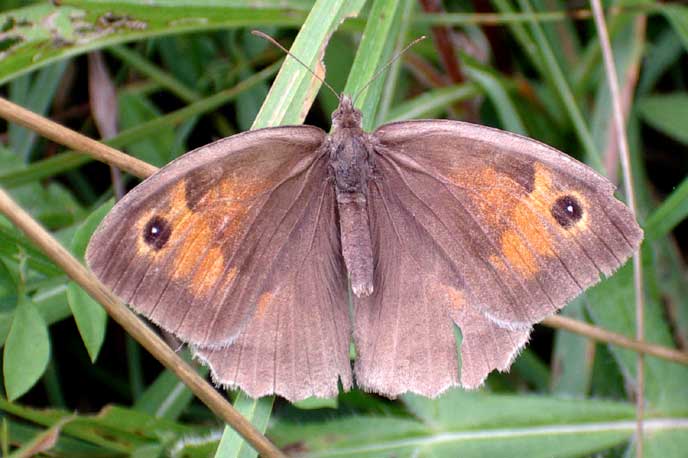 |
 |
 |
 |
|
|
|
|
|
Some Indicator
Plants of Ancient Downland
 |
 |
 |
 |
|
|
|
|
|
Other
indicators on the lower slopes include Dropwort,
Autumn
Ladies Tresses (upper plateau), Hairy
Violet,
all
of which are rarely found on pastures, restored wildlife meadows or agricultural
downland. Other downland plants that are more likely on the biodiverse
down herbland are Wild Thyme,
Carline
Thistle, Dwarf Thistle, Squinancywort,
Fairy
Flax, Small Scabious,
Common
Centaury and
Wild
Basil. There are other more widespread
wild plants like the Mouse-eared Hawkweed,
Rough Hawkbit, Lesser Hawkbit, Bird's Foot Trefoil, Ground
Ivy, Germander
Speedwell, Field Speedwell, Sweet Violet,
Self-heal
and Yellow Wort.
Wild
Flora and Fauna on Chalk flickr
Adur
Wild Flowers 2009
| OVERVIEW:
A large part (724 acres) of the downs including Mill Hill were presented to the people of Shoreham in 1937. Just over 30 acres still remain as public open land and a Local Nature Reserve. This is divided into about 11 acres of grassland and meadows above the ridge, about 9 acres of scrub, the copse and glades at the northern end, and about half of the prime Chalkhill Blue area of 6.4 acres of herbland remaining. 6 acres has been lost to a Sycamore woodland on the southern slopes. This is low fertility chalkland not suitable for grazing. The top area is effectively a wild meadow and the lower slopes a rabbit warren dominated by prostrate (not the upright form) Horseshoe Vetch, Hippocrepis comosa. |

Horseshoe Vetch |
||||||
| Chalkhill Blues:
Mill
Hill is nationally important because of its population of Chalkhill
Blue Butterflies. Estimates of the numbers
are notoriously inaccurate. In the 1950s
the population was estimated by R. M. Craske
to
be 50,000. This may be an exceptionally good year. I would estimate the
numbers at that time to be nearer 25,000 for Mill Hill only. After the
cattle grazing and thorn incursions the numbers plummeted to the most reliable
estimate in 1960
of 6,000. The new road and Sycamore woodland further denuded the Horseshoe
Vetch, Hippocrepis comosa,
and bare chalk downland to a figure I have estimated at a top figure of
3,000 Chalkhill Blue Butterflies at the turn of the millennium (counted
in 2003). Almost
all these butterflies are now to be found on the six acres of the lower
slopes.
|
 |
||||||
| "Our
family lived at The Mill House, Mill Hill, from around 1933
until about 1967, and every July we saw the
"Butterfly Men" walking past onto the Downs. My father used to tell
us that they were interested in the blue butterflies."
Heather
Clark (née Eager), Ryde, Isle of Wight
|
Nearest
Postcode: BN43 5FH
Grid Ref: TQ 21170 07444 (upper car park) Geographic Link OS Map Google Earth Map Magic Map of Mill Hill NR Local Nature Reserve Designation Natural England: Local Nature Reserves Multi-Map (Bird's Eye View) Grid Reference Finder |
FEATURE:
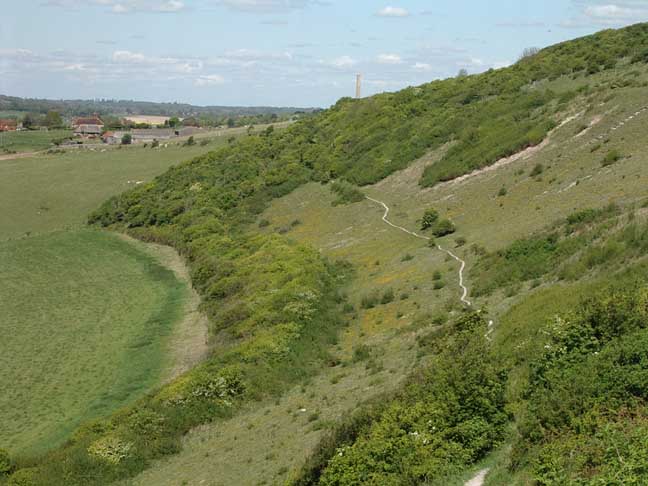
 |
The butterfly lower slopes at Mill Hill are under serious threat by a natural process known as ecological succession where the woody shrubs like Privet, Brambles and Hawthorn invade the herb-rich slopes gradually turning the downs into woodland and eliminating the butterfly larval food plants especially the Horseshoe Vetch, Hippocrepis comosa, on which the Chalkhill Blue Butterflies rely. The remedy is by expert professional removal of the Privet on a regular basis. This job is now being undertaken by volunteers. |

 |

flickr |

|
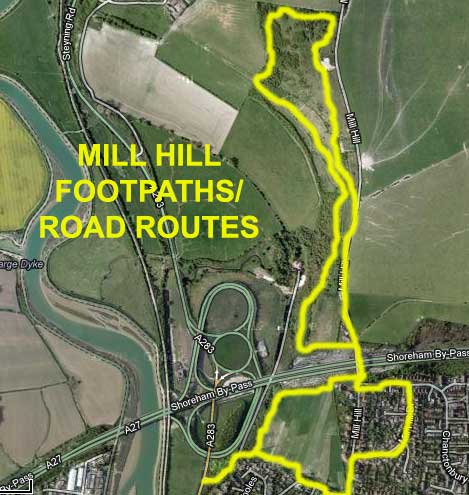 |
OS
Map
Footpaths at Mill Hill |
18 December 2021
Quercus
ilex - Holm Evergreen Oak Tree
Upper
Mill Hill
2 November 2021
Mill Hill from the south
A rambler reported a bright yellow Clouded Yellow Butterfly over the top southern part of Mill Hill. The dead vegetation on the upper meadows had been forage harvested since my last visit, but the dried grasses in the image below remained. I heard the whirring of a Pheasant taking off from the pasture to the east.
22 October 2021
Kestrel over Mill
Hill
Photograph
by Ken Sillence
Plateau at the upper part of Mill Hill
22
September 2021
A
Comma
Butterfly visited blackberries
at the top of the southern steps to the lower slopes where two Clouded
Yellow Butterflies chased each other over
a large area. Other butterflies
were occasional Meadow
Browns,
a worn and damaged Adonis Blue,
occasional
Common
Blues,
a few Whites,
and a few Small Heaths. A
Common
Lizard skitted across the winding path.
17
September 2021
A
Clouded
Yellow Butterfly flew restlessly over
the upper part of Mill Hill searching for nectar amongst the paucity of
flowers.
16 September 2021
Hawthorn on Mill Hill
6 September 2021
Devil's
Bit Scabious, Buddleia
Painted
Lady
Adonis
Blue, Carline Thistle
Greater
Knapweed
Scores of House Martins flew to and fro over Mill Hill prior to emigration. A trek to the lower slopes was curtailed because of excessive warmth and humidity. Devil's Bit Scabious was seen flowering at the northern end. The usual gamut of butterflies included 40+ Meadow Browns, 12+ Adonis Blues, 8+ Chalkhill Blues, occasional Common Blues, frequent Whites, frequent Small Heaths, at least one each of Clouded Yellow, Brown Argus, Painted Lady (2), Red Admiral.
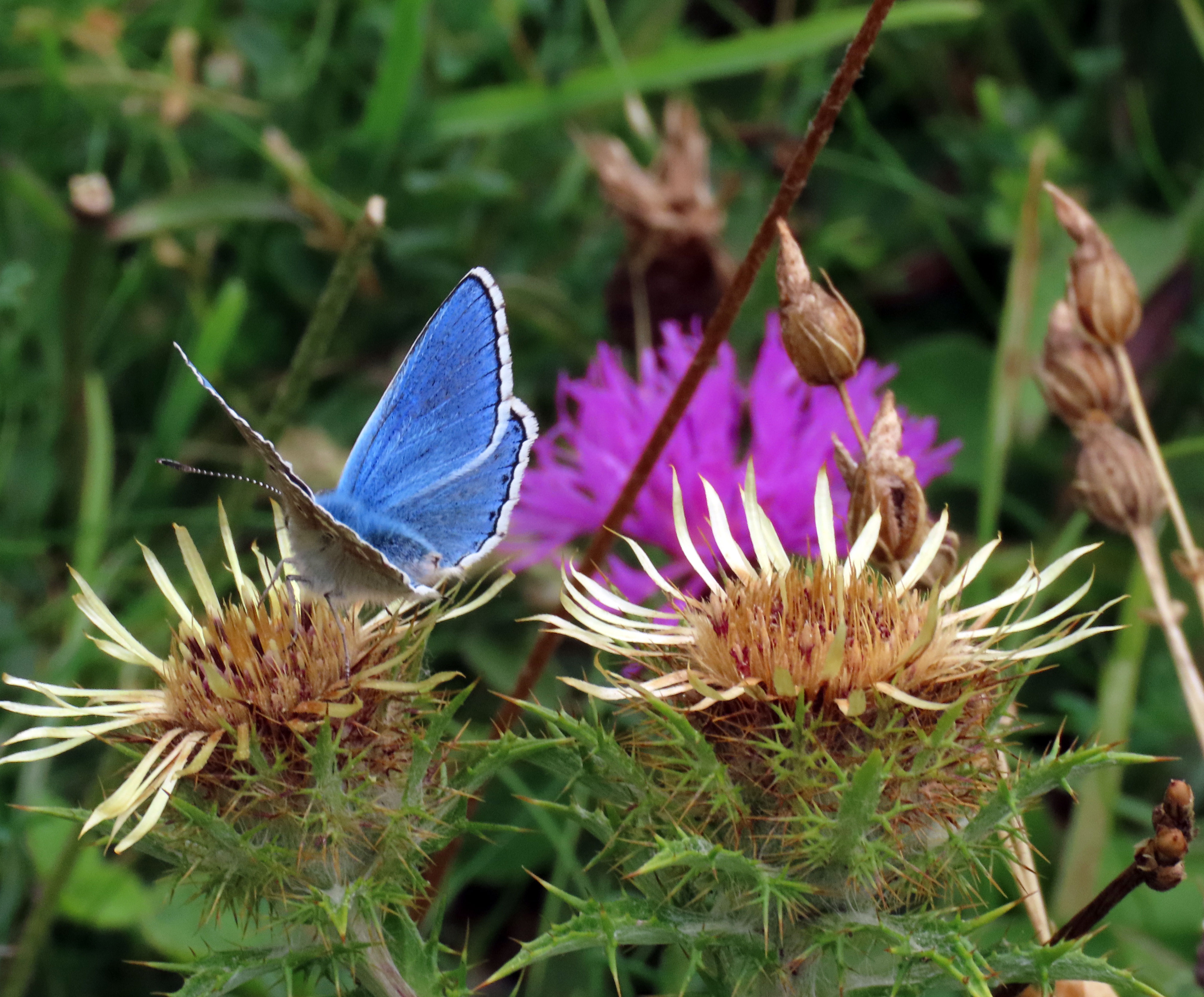
Adonis Blue on Carline Thistle
A Kestrel hovered over Mill Hill until after a few minutes a dog appeared and it flew off. Scores of butterflies were disturbed over the lower slopes and for a few minutes when the sun shined in the afternoon this rose to nearly two hundred: 80+ Meadow Browns, 30+ Adonis Blues, 25+ Chalkhill Blues, occasional Common Blues, a few Large Whites, Small Heaths, at least one each of Clouded Yellow, Small Copper, Brown Argus and Treble-bar and Carpet Moths.
Meadow Vetchling, Ploughman's Spikenard, Lesser Knapweed
20
August 2021
Ten
species of butterfly
were seen on the top of Mill Hill on a black cloudy afternoon: frequent
Meadow
Browns,
occasional
Common
Blues,
three Chalkhill
Blues, a few Large
Whites, Red Admirals,
at least one each of Peacock Butterfly,
Wall Brown, Painted Lady, a pair of Small
Tortoiseshells and a Small
White.
Adonis
Blue with Basil,
Meadow
Brown
with
Lesser
Knapweed
Common
Blues
Overcast
and breezy, an afternoon visit to the lower
slopes of Mill Hill was greeted by my first of the year and an extremely
bright Clouded Yellow Butterfly
sparring with the first of 35+ Chalkhill
Blues. Most
of the butterflies on my half transect
were resting and needed to be disturbed to be seen. 100+ Meadow
Browns,
at least three of the second brood male Adonis
Blues, occasional
Common
Blues,
at least two of Peacock Butterflies,
Wall Browns, one each of a good condition
Painted
Lady, Large White
and a Small Heath,
were seen in under an hour. On the southern steps, (where the Sloe
berries
had turned dark) there were at least two
Speckled
Woods. Add more Common
Blues
resting
and mating amongst the long grasses on the top part of Mill Hill south
of the Reservoir plus Red Admirals
around the Buddleia.
Both
the Kite-tailed Robberfly, Tolmerus
atricapillus and the Hornet
Robber Fly,
Asilus
crabroniformis skulked on the paths.
Carpet
Moths were disturbed. A Common
Lizard skitted across the southern steps.
Notable flora included Ploughman's Spikenard, Carline Thistle, Wild Mignonette, and one spike of Autumnal Hawkbit (ID checked) with the more prevalent Lesser Hawkbit and Rough Hawkbit. And large patches of Hawkweed Ox-tonque on the lower slopes was new. Pineapple Weed was present by the gates of the southern car park.
10
August 2021
Late
in the afternoon, a brief visit to the top of Mill Hill hosted frequent
Meadow
Browns,
Common
Blues,
Red
Admirals, and occasional Peacock
Butterflies and
Small
Tortoiseshells.
5 August
2021
Rain
stopped play again in the afternoon, but not
before I counted 40 restless male Chalkhill
Blues
on a quarter transect of the lower slopes of Mill Hill, plus a notable
20+
Peacock Butterflies
attracted to the Buddleia
in flower with a few Red Admirals
and Painted Ladies
and the usual gamut of Gatekeepers, Meadow
Browns,
Brimstones, Common Blues.
Large Whites and 6-spotted
Burnet Moths.
| With
the afternoon sun, out came the butterflies
on the top of Mill Hill.
75+
male Chalkhill Blues
Moths:
Predators:
Main
plants visited:
|
|
| I
was impressed by the scores of Round-headed
Rampion flowers
on the plateau south of the upper car park. Numbers were in the low
hundreds. The small umbellifer Burnet
Saxifrage and the Small
Scabious were also noted.
Adur Scabious I noted
small amounts of Restharrow,
Wild
Mignonette and Yellow
Vetchling.
|
3 August 2021
Chalkhill Blue
Butterflies
fluttered over the lower slopes of Mill Hill under a cloudy sky in the
afternoon. Frequent 25+ Gatekeepers,
25+ Meadow Browns,
30+ Chalkhill Blues,
including a mating pair,
were joined by occasional Large Whites
and at least one each of a Marbled White,
female Common Blue,
Peacock, and Small
Tortoiseshell. Treble-bar
Moths, Yellow
Shell Moths and
6-spotted
Burnet Moths were seen. A Kite-tailed
Robberfly, Tolmerus atricapillus,
waited in ambush. There was one large brown
Oak
Eggar Moth
caterpillar crawling over the path. On
the top part south of the reservoir, I added a Brimstone
Butterfly. Painted Lady and Small
Heath.
2 August 2021
Melilot,
Greater
Knapweed
Fleabane,
Wild Parsnip, Dwarf Thistle
Lower
Slopes of Mill Hill
After
a rain sodden and cloudy week, moderate rain curtailed my visit to Mill
Hill before any resting butterflies
were disturbed on the lower slopes. Dwarf
Thistle was common. The first shoots of
Carline
Thistle were seen. House
Martins flew over the downs.
Flora
Gallery
Adur
Thistles
Adur
Knapweeds
23
July 2021
At
last, a handful of male Chalkhill Blue
Butterflies fluttered restlessly over
the lower slopes of Mill Hill.
Large White on Bristly
Ox-tongue, Lesser Centaury
(very small flowers) with Eyebright.
Chalkhill
Blue on
Ragwort
Dwarf
Thistle
19 July 2021
Gatekeeper
on Perforate St. John's Wort, Wild Basil
Round-headed
Rampion,
Dwarf
Thistle
I visited
the lower slopes in the sunshine where there were frequent butterflies:
Gatekeepers,
Meadow
Browns, Marbled Whites. Large Whites,
Small
Skippers, a Red
Admiral,
a
Small Heath, but no Chalkhill
Blues.
Notable
flowers were hundreds of Wild Basil,
frequent Round-headed Rampion,
frequent
Small Scabious, Common Centaury, Dwarf Thistle
and
Perforate
St. John's Wort,
Lesser
Hawkbit.
18
July 2021
On
a virtually cloudless day the sun (25º
C) burned anybody who ventured out of the
shade. I still visited the upper part of Mill Hill in the mid-afternoon
where two dozen butterflies fluttered
around the attractive selection of chalkhill flowers
amongst the long grasses south and west of the top car park. Marbled
Whites. Large Whites,
and
Meadow
Browns
were
all restless. There was at least one Small
Heath, a probable Wall
Brown and my first Painted
Lady of the year on the middle slopes
south of the copse,
Round-headed Rampion, Small Scabious, Pyramidal Orchid
Notable flowers were frequent and more than usual Round-headed Rampion, frequent Small Scabious, and Greater Knapweed on the exposed top of the hill. On the sheltered middle slopes the notables were Melilot, Lady's Bedstraw, Marjoram, and Field Scabious.
14 July 2021
Marjoram, Centaury. Squinancywort, Dwarf Thistle
A couple of Gatekeepers on the southern steps to the lower slopes were the first of the year, Other butterflies were occasional Marbled Whites. Large Whites, Meadow Browns, Red Admirals, a few Small Skippers, Small Heaths and one Wall Brown.
28
June 2021
Marbled
White Butterflies were very lively over
the lower slopes of Mill Hill where I also spotted my first Small
Skipper of the year. New flowers
appeared on a cloudy humid afternoon. Small
Heath Butterflies, pristine Red
Admirals, large Meadow
Browns,
a
Silver Y Moth
and a 6-spotted Burnet Moth
were noted as the first spots of rain were felt.
A
Great Green Bush Cricket, Tettigonia
viridissima, was spotted on the southern top part of Mill
Hill for the first time.
Adur
Crickets and Grasshoppers
Knapweed (white) and
Knapweed
Broomrape
Southern
top part of Mill Hill

A Buzzard soared over a sunny (19°C) Mill Hill in the early afternoon. Butterflies were lively and frequent: Common Blues, Dingy Skippers, Small Heath Butterflies, Brimstones and Silver Y Moths over the lower slopes. A Holly Blue fluttered by the hedge by the southern car park to Mill Hill.
Dropwort,
Dog Rose
Thyme
31
May 2021
Butterflies
fluttered over the sun-drenched (21°C)
lower slopes of Mill Hill: 30+ male Common
Blues, 4+ male Adonis
Blues, frequent Dingy
Skippers and Grizzled
Skippers, my first Brown
Argus
and
Cinnabar Mothof
the year, frequent Brimstones,
a few Small Heath Butterflies
and a probable Wall Brown.
By the flowering Hawthorn-lined
road there was a Holly Blue.
All the butterflies were restless.
On
the southern top of the hill, the first Greater
Bird's Foot Trefoil was seen in flower.
Common
Bird's-foot Trefoil Lotus
corniculatus is shorter and grows in dry grassland. Its stems are
solid whereas the stems of Lotus
pedunculatus are hollow.
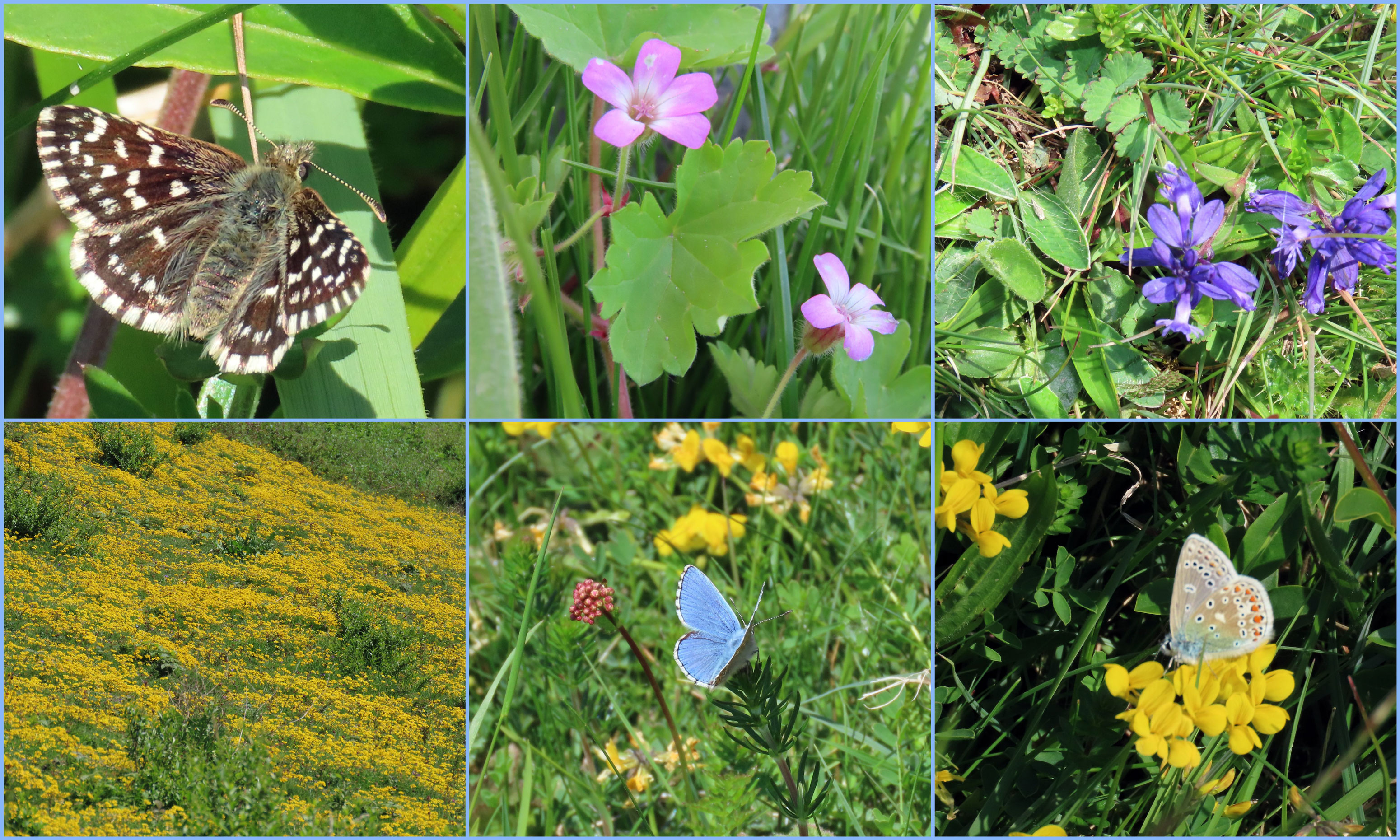
Grizzled
Skipper, Round-leaved Cranesbill, Milkwort
Horseshoe
Vetch, Adonis Blue Butterfly, Common Blue
The sun shined in the afternoon for the first time in over a week, I was able to confirm my first male Adonis Blue Butterfly of the year with frequent Brimstones but not many other butterflies on the lower slopes of Mill Hill. There were occasional amorous Wall Browns. a few Small Heath Butterflies, a few Dingy Skippers, Grizzled Skippers, and Common Blues (including a dark blue female). At the top of Chanctonbury Drive, there was the flutter of a Holly Blue and some Large Whites. Early Elderflower appeared.
19 May 2021
May Gallery on facebook
Swathes of Horseshoe Vetch, Hippocrepis comosa, covered the lower slopes of Mill Hill on a cloudy afternoon inimical for watching butterflies. In an hour I spotted to my first of the year Small Heath Butterfly and a few first of the year Dingy Skippers, at least three male Common Blues, a Brimstone Butterfly, a few Large Whites and Red Admirals. At the top of Chanctonbury Drive, the flutter of blue was a Holly Blue.
Hawthorn was beginning to flower in the hedgerows. Patches of Crosswort, Cowslips and Germander Speedwell decorated the area south of the Reservoir.
A Buzzard soared overhead mobbed by the frequent Crows. And a rather scruffy Jay put in two appearances.
12
May 2021
Five
o'clock in the afternoon is a bit late in
the day for seeing active butterflies
on the lower slopes of Mill Hill as most of them will have gone to roost.
I managed to spot my first male Adonis Blue
(not confirmed -subsequently thought to be a Common
Blue), and my first of the year Small
Copper visiting the abundant Horseshoe
Vetch, Hippocrepis comosa.
A
flock of up to a dozen corvids, mostly Jackdaws.
were persistently feeding on something amongst the short vegetation on
the steeper slopes. A Peacock Butterfly
flew down and I disturbed a handful of Grizzled
Skippers. Hawthorn was
beginning to flower.
Cowslips
were seen south of the Reservoir.
Hawthorn,
Wayfaring
Tree
Cowslips,
Dog
Violets
7
May 2021
Tripping
over butterflies at Mill Hill today with a grand total of 14 species recorded.
Dozens of Dingy Skipper & Grizzled Skipper, Green-veined White, Small
White, Brimstone and a singleton Orange-tip doing the rounds. Wall are
coming along nicely with at least half a dozen bobbing around, a female
already ovipositing. A handful of Small Copper seeing off all-comers which
included my first Common Blue of the year, around 6 males seen. Green Hairstreak
also doing well, regularly getting stuck in with the multi species aerial
brawls, again about half a dozen active. The afternoon brought out 4 or
5 fresh looking Peacock and like Abbots Wood on Wednesday, there were good
numbers of fresh immigrant Red Admirals, a female was seen egg laying (from
the state of some they must have come via Jersey!). A single Comma made
a very brief appearance (unable to tell if it were an early hutchinsoni
or a late hibernator). The day started off with a rare Sussex sight of
a female Small Tortoiseshell avidly investigating some nettle on the edge
of the horse paddocks on the south side of the Shoreham Bypass.
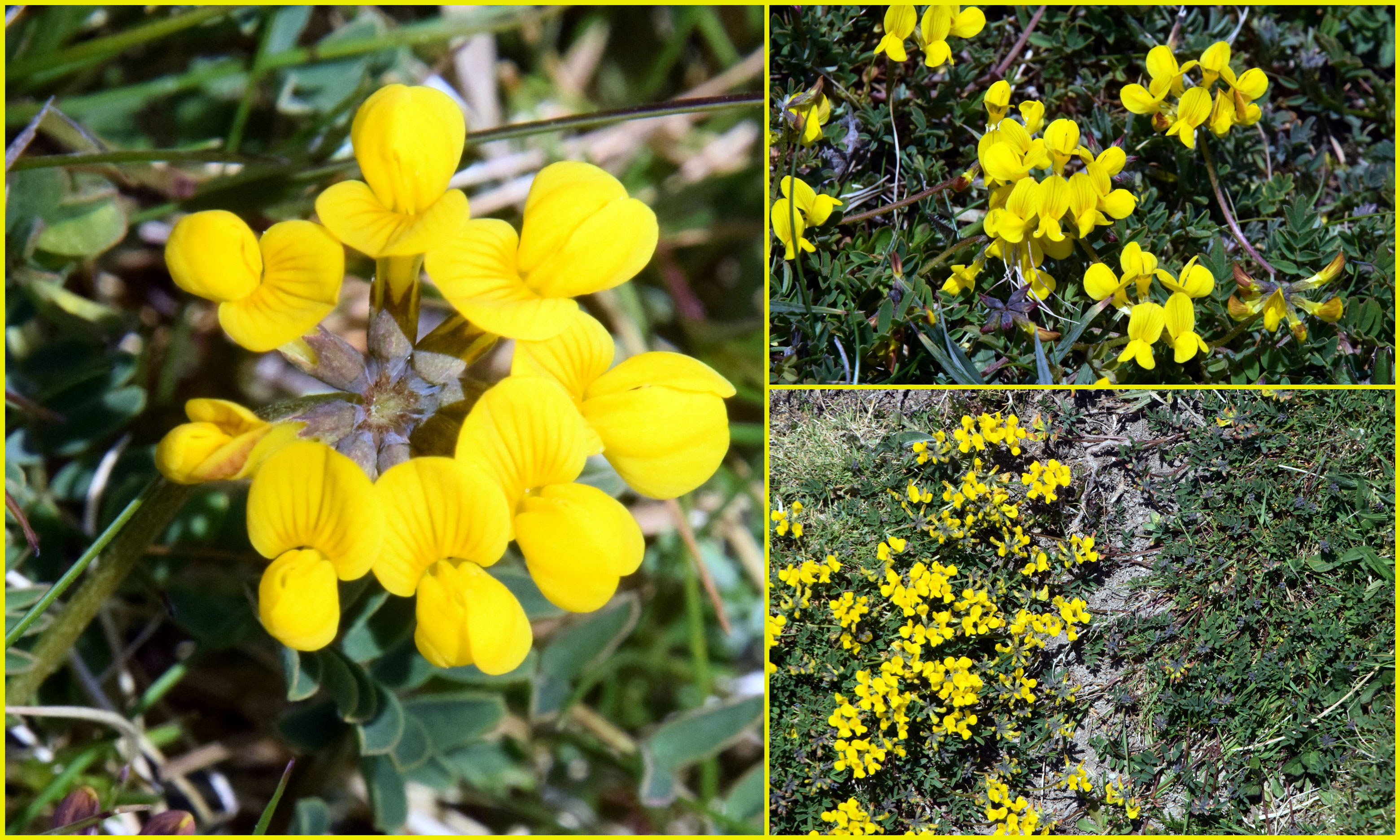
Horseshoe Vetch, Hippocrepis comosa
I only managed to spot eleven species of butterfly, the last seven on the lower slopes of Mill Hill: Red Admiral, Speckled Wood, Small White, Large White, Green-veined White, Brimstone, Wall Brown, Peacock, Grizzled Skipper, Dingy Skipper, Common Blue. I also noted a few pyralid moths Pyrausta nigrata. Blackthorn had ceased to flower.
Mill Hill Nature Reserve on facebook
22 April 2021
Blackthorn
A few Peacock Butterflies visited the battered and frequent Sweet Violets and Dog Violets scattered thinly over the lower slopes of Mill Hill. A bright yellow Brimstone Butterfly fluttered by the Holly Tree, where the Wayfaring Tree had been hacked down by the conservation workers.
19
April 2021
15 April 2021
Mill Hill (south)
Mill
Hill Wildlife Reports 2020 (Link)
Mill Hill Wildlife Reports 2018 (Link)
Mill
Hill Wildlife Reports 2016 (Link)
Mill
Hill Wildlife Reports 2015 (Link)
Mill
Hill Wildlife Reports 2014 (Link)
Mill
Hill Wildlife Reports 2013 (Link)
Mill
Hill Wildlife Reports 2012 (Link)
Mill
Hill Wildlife Reports 2011 (Link)
Mill Hill Nature Reserve on facebook
Identification
of Grasses (Link)
Mill
Hill Grasses
 |
A
Nature
Reserve is defined in Section 15 of
the National Parks and Access to the Countryside Act 1949,
as land managed for the purpose:
(a)
of providing, under suitable conditions and control, special opportunities
for the study of, and research into, matters relating to the flora and
fauna of Great Britain and the physical conditions in which they live,
and for the study of geological and physiographical features of special
interest in the area; or
|
17+
SPECIES OF BUTTERFLIES DEPENDENT ON MILL HILL
FOR BREEDING:
(Estimated
numbers for Mill Hill Nature Reserve only
are in brackets)
| Chalkhill
Blue (3000 +)
Adonis Blue (50 -100) Dingy Skipper (75) |
Small
Heath (250)
Wall Brown (12) Meadow Brown (300) |
Marbled White (50)
Gatekeeper (200) Speckled Wood (>50) Green-veined White (2+) |
Common
Blue (>4000+)
Small Blue (5) Brimstone (8) |
Small
Skipper (>50)
Large Skipper (10+) Grizzled Skipper (20) Brown Argus (>30) Green Hairstreak ( a few) |
The other species may breed on Mill Hill, but there main breeding area will be adjoining fields or slightly further away. e.g. Small Blue (included above), Small Copper, Small Tortoiseshell, Green-veined White, Peacock, Ringlet, Small White, Large White, Comma, Holly Blue, Orange Tip. (=10). There are huge variances each year for most species.
The following are immigrants &/or hibernators: Red Admiral, Painted Lady, Clouded Yellow.
The following have not been positively identified (because of ID difficulties): Essex Skipper. This species is now included for a local field on the Adur Levels within 500 metres of Mill Hill.
(=30)
The
following was confirmed only in 2009:
Green
Hairstreak.
(=31)
The
following was confirmed only in 2014: Dark
Green Fritillary
(=32)
The next one is no longer
found on Mill Hill but were there in the distant (1947) past: Grayling.
The next one has been recorded
near Mill Hill in the middle distance past: White-letter
Hairstreak
(=34)
The
Silver-spotted
Skipper does not appear to ever have occurred
on Mill Hill
The
Silver-studded
Blue has never been recorded from Mill Hill
The Short-tailed Blue was recorded as a single immigrant in 1956.
17
August 2009
A
possible (unconfirmed) Brown Hairstreak Butterfly
was
spotted. A confirmed one was spotted nearby.
2017
Brown
Hairstreak and Silver-spotted
Skipper have been confirmed from Mill
Hill. The first is notoriously difficult to spot and was probably already
there. The skipper
may be a new addition, but it is small and not easy to spot, and there
have now been numerous sightings
Aerial
Map
Lower
Adur Levels (MultiMap) including Lancing Clump and Mill Hill
Horseshoe
Vetch, Hippocrepis comosa
First
Draft of the Article for the Shoreham Society Newsletter